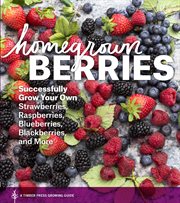Nonfiction
eBook
Details
PUBLISHED
Made available through hoopla
DESCRIPTION
1 online resource
ISBN/ISSN
LANGUAGE
NOTES
Enjoy delicious, nutritious berries from your own backyard! What says summer more than a bowl full of fresh berries? How about a yard full of them? Homegrown Berries covers the information you need to know about the process from planting to picking. You'll learn the best varieties of strawberries, raspberries, blackberries, blueberries, gooseberries, currants, and elderberries for you, how to fit them into your landscape (including in borders and containers), and how to maintain them for peak harvest. Summer just got sweeter! Berry lovers and home gardeners now have a guide for selecting, sitting, planting, caring, and harvesting strawberries, raspberries, blueberries, blackberries, and more. Timber Press is devoted to sharing the wonders of the natural world by publishing books from experts in the fields of gardening, horticulture, and natural history. Founded in 1978, Timber Press is internationally recognized as the leading gardening publisher. Its books and authors have received awards from the American Horticultural Society, the Garden Writers of America, the Garden Media Guild, the National Garden Club of America, and more. Introduction: You Can Do It! Whether you are new to gardening berries, or new to gardening altogether, this book will help you welcome tasty, healthful, beautiful berries to the world that lies just beyond your doorstep. Just one homegrown berry, plucked on the way from drive to doorbell, can bestow a dizzying flavor profile, from sweet to tart to simply divine, and the ways to incorporate berries into the landscape can be similarly satisfying and diverse. Perhaps it'll be as subtle as a delicate edging of strawberries along the path leading up to your front stoop. Or maybe it'll be a bigger story, like a row of plump blueberry bushes or a property-defining fence, covered in trailing blackberries. What is a berry exactly? To botanists, a berry is a fruit that is multiseeded and derived from a single ovary. So, before we embark on this berry-growing journey, a confession: some of the fruits in this book (blueberries, currants, gooseberries, elderberries) are true berries; others (strawberries, raspberries, blackberries, Juneberries) are not. But for the purposes of this book, the common term "berries" will be employed for all. More important than terms, of course, are the joy, satisfaction, and delicious harvests your plantings will provide for seasons to come. The basic concept of growing berries is hardly revolutionary-this diverse group of fruits has been a source of sustenance throughout history-but the ornamental value of berries in the landscape is increasingly recognized and celebrated. It's entirely doable to have a good-looking display that also feeds you and your family. Growth habits of berry plants range from groundcovers (strawberries) to vines that require support (trailing blackberries) to upright, freestanding shrubs (highbush blueberries). Any of these can become a significant part of your home landscape, as productive as a good vegetable garden or small home orchard and, with savvy siting and good care, no less attractive. If your yard space is at a premium, a collection of containers is a viable planting option for most of the berries in this book. And the ever-growing abundance of available cultivars means gardeners don't have to choose between the delicious, beautiful, and disease-resistant attributes of a plant. We can have it all-an edible, natural-looking landscape that requires minimal maintenance once established. So, how to decide which berries are a good fit for you? Berry by berry, the chapters in this book will walk you through the best selections for home cultivation. You may choose to grow exotic-sounding elderberries or black currants simply because they are impossible to find at your local grocery store. Or perhaps you'l
Mode of access: World Wide Web







